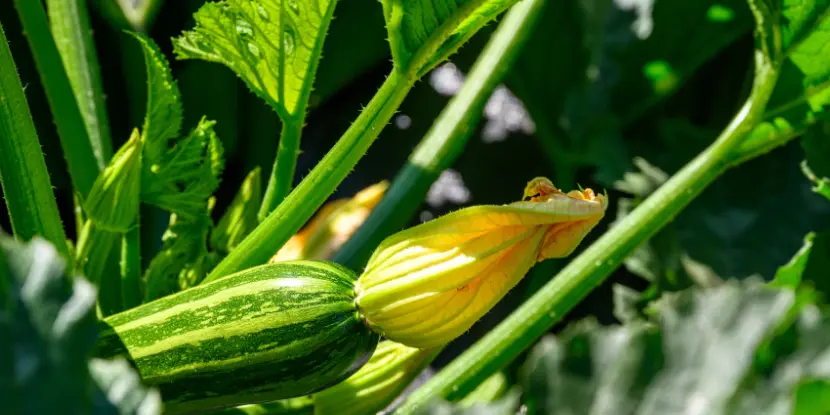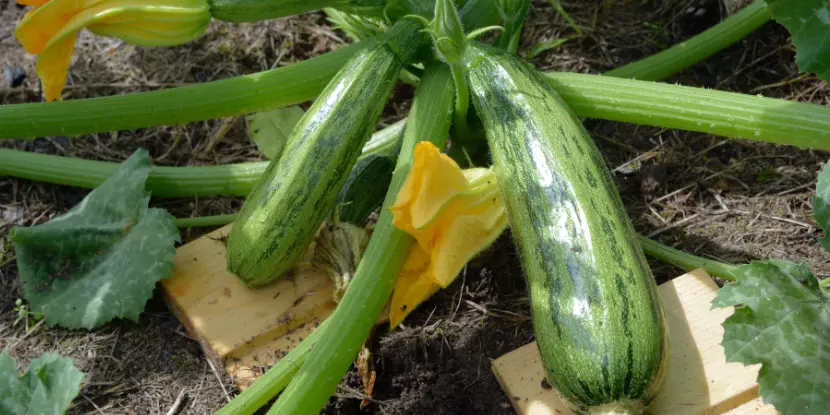Zucchini originated in Mesoamerica, the region extending from central Mexico through Belize, Guatemala, El Salvador, and Honduras.
It’s a relatively recent addition to gardens but has been cultivated since at least the mid-19th century. Records from the 1800s suggest that the elongated Italian variety of squash, known as zucchini, originated in northern Italy, along with Stradivarius violins.
Zucchini is low in calories and high in essential nutrients like vitamins C and A. It contains antioxidants that protect cells from damage and provides significant amounts of potassium, magnesium, and folate for cardiovascular health and muscle function. Its high fiber content aids digestion and helps maintain a healthy weight.
Mild winters, warm summers, abundant sunshine, and well-draining soils make Southern California a prime region for zucchini cultivation. The long growing season allows for multiple abundant harvests.

A nearly-ripe zucchini fruit on the vine.
Picking the Perfect Zucchini
So many zucchinis, so little time! Popular varieties include:
- Black Beauty: This reliable and productive variety has dark green skin and firm, tender flesh.
- Golden Zucchini: A slightly sweeter variety with an eye-catching yellow color. It performs exceptionally well in California’s intense sunlight.
- Cocozelle: An heirloom variety with striped skin and robust flavor, prized for its versatility in cuisine.
- Eight Ball: A round zucchini perfect for stuffing and grilling. Its compact size makes it ideal for small garden spaces or container gardening.
- Raven: Distinguished by its almost black skin and tender texture, Raven zucchinis are known for their disease resistance and heavy yields.
- Costata Romanesco: An Italian heirloom with distinctive ribbed skin and exceptional flavor. Chefs favor it for its superior taste and texture.
Where to Buy Seeds
You’ll find zucchini seeds at your local Anawalt garden center, online retailers, or seed catalogs. Look for organic and non-GMO options to ensure a healthy and sustainable garden. If you order online, pick a variety suitable for your area.
Preparing the Garden
Soil Requirements
Zucchini flourished in well-draining, fertile soil with a pH between 6.0 and 7.5. Follow these steps to prepare your garden bed:
- Use a soil test kit to determine your soil’s pH and nutrient levels.
- Based on the results, amend the soil with compost, well-rotted manure, or organic fertilizers to create a nutrient-rich environment.
- Zucchini plants hate soggy feet. Add sand or plant in raised beds if your soil is heavy clay.

Young zucchini plants in the garden.
Planting Location
- Zucchini plants require at least 6–8 hours of full sunlight daily. Find a location in your garden that receives ample sunlight throughout the day, preferably with southern or western exposure.
- Avoid spots shaded by large trees, buildings, or other structures.
- Zucchini loves warm conditions. The location should have good air circulation and protection from cold drafts, strong winds, and frost. If needed, you can use row covers or cloches for added protection.
Preparing the Garden Bed
- Clear the planting area of debris, weeds, and rocks.
- Loosen the soil to a depth of 12–18 inches.
- Remove any large clumps or stones from the soil bed.
- Smooth out the surface with a rake until it’s relatively flat.
Planting Zucchini: Timing & Techniques
- Zucchini plants don’t transplant well. Sow seeds directly in groups of two or three about an inch deep into the soil bed.
- If you’re starting seeds indoors, use biodegradable, plantable pots that you can plant directly into the soil. Otherwise, start in regular 2-inch pots and transplant when the seedlings have at least two sets of true leaves.
- If you’re starting seeds outdoors, wait until all danger of frost has passed and the soil temperature is at least 60°F.
- Plant seeds or transplants about three feet apart in rows about five feet apart. Zucchinis are heavy feeders and need room to grow.
- Create small mounds around each group of plants to help with drainage and prevent waterlogging.

Zucchini flowers with attached young fruit.
Maintaining Your Zucchini Plants
Watering Zucchini
- Water zucchini plants deeply and consistently. Aim for about 1–2 inches of water per week from rain or irrigation.
- Water your plants early to reduce evaporation and allow the foliage to dry before evening. This helps prevent fungal diseases.
- Use a soaker hose or drip irrigation system to deliver water directly to the soil around the plants’ bases. Avoid overhead watering, which can promote leaf diseases.
- Check the soil moisture regularly. Stick your finger 1–2 inches into the soil; if it feels dry, it’s time to water.
- Apply organic mulch, like straw or wood chips, around the base of your zucchini plants. Mulch helps retain soil moisture, regulates soil temperature, and reduces weed growth.
- Monitor your plants for signs of drought stress, such as wilting or yellow leaves. Increase watering frequency during hot, dry spells to keep plants hydrated.

A zucchini fruit with flower still attached.
Fertilizing Zucchini
- Before planting, incorporate a balanced, all-purpose fertilizer (i.e., 10-10-10) into the soil. Follow the package instructions for the appropriate amount.
- About 4–6 weeks after planting, side-dress your zucchini plants. Scatter a granular fertilizer around the base of each plant, keeping it a few inches away from the stems. Lightly work the fertilizer into the soil and water thoroughly.
- Use compost or well-rotted manure as a top dressing. Spread a thin layer around the base of the plants to provide a slow-release source of nutrients.
- Apply a water-soluble fertilizer every 3–4 weeks according to the manufacturer’s instructions. Alternatively, use a balanced liquid fertilizer, diluted to half strength, and apply it during your regular watering routine.
- Watch your plants for signs of nutrient deficiency, such as yellowing leaves or stunted growth. If you notice these symptoms, consider applying a foliar spray of fish emulsion or seaweed extract to boost nutrient levels.
- Once plants start to decline towards the end of the growing season, apply a final dose of compost or organic fertilizer to revitalize the soil and prepare it for next year’s crop.

Zucchini fruit placed on wood blocks to protect it from contact with the ground.
Controlling Pests & Diseases
- Inspect your zucchini plants frequently for signs of pests or diseases. Look under the leaves and around the base of the plant for any unusual discoloration or damage.
- Encourage natural predators, like ladybugs and lacewings, to inhabit your garden. They control pest populations by feeding on aphids, whiteflies, and other harmful insects.
- Remove larger pests by hand and dispose of them properly. Wear gloves if needed, and check your plants regularly for infestations.
- Use organic neem oil to treat infestations. Neem oil is effective against a variety of insects and also has antifungal properties.
- Use floating row covers to protect your zucchini plants from insect pests. Ensure the covers are secure and leave enough room for the plants to grow.
- Rotate your zucchini crops yearly to prevent the buildup of soil-borne diseases and pests. Avoid planting zucchini in the same spot for at least three to four years.
- Allow proper spacing between plants to promote good air circulation. This reduces the humidity around the plants, lowering the risk of fungal diseases.
- Maintain a clean garden by removing plant debris and weeds. This removes potential breeding grounds for pests and pathogens.
- Overwatering can lead to root rot and attract pests. Water your plants deep but infrequently, allowing the topsoil to dry out between watering sessions.
- When possible, choose disease-resistant zucchini varieties.
Harvesting & Storing Zucchini
When to Harvest
Zucchini grows fast. Timing is key to harvesting the best fruits:
- Harvest zucchinis when they’re 6-8 inches long for the best flavor and texture.
- Zucchinis can go from perfect to overripe in days, so check your plants often.

A mother and son harvesting zucchini.
How to Harvest
Use a sharp knife or pruner to cut the fruit from the vine, leaving a short stem attached. Be gentle to avoid damaging the plant. Sterilize the knife or pruners with diluted rubbing alcohol spray.
Storing Zucchini
Freshly harvested zucchinis can be stored in the refrigerator for up to a week. For more extended storage, consider freezing, pickling, or dehydrating.
FAQs: Growing Zucchini
Q: How much space do zucchini plants need?
Zucchini plants can spread quite a bit, so give them plenty of room. Space plants 2–3 feet apart in rows 3–4 feet apart.
Q: Can I grow zucchini in containers?
Yes. Choose a large container (at least 18 inches in diameter) with good drainage. Use high-quality potting soil and place the container in a sunny location.
Q: Why are my zucchini flowers falling off?
It’s normal for male flowers to fall off after a few days. However, if female flowers drop, it might be due to poor pollination. Encourage pollinators by planting flowers nearby or hand-pollinate using a small brush.
Q: How do I prevent my zucchinis from becoming bitter?
Practice consistent watering and timely harvesting. Zucchinis become bitter if stressed or left on the plant for too long.
Q: What can I do with excess zucchini?
You can grill, sauté, bake, or spiralize it and use it in bread, muffins, or as a base for soups and stews.
Q: What type of soil is best for growing zucchini?
Zucchini thrives in well-draining soil rich in organic matter. A slightly acidic to neutral pH range of 6.0 to 7.5 is ideal. Amending the soil with compost or aged manure can improve its fertility and structure.
Q: Why are my zucchini fruits rotting on the vine?
This could be due to blossom end rot, usually caused by a calcium deficiency or inconsistent watering. To ensure your plants receive even moisture and avoid fluctuations in soil moisture, add calcium to the soil.
Q: How can I increase pollination in my zucchini plants?
Plant flowers that attract bees and other pollinators near your zucchini. Avoid using pesticides that can harm these beneficial insects. Using a small brush, you can also hand-pollinate by transferring pollen from male to female flowers.
Q: Can zucchini plants be grown indoors?
Yes, with sufficient light. Place the plants in a sunny window or deploy grow lights that provide at least 6-8 hours of direct light daily. Choose compact or bush varieties that are more suitable for indoor gardening.

